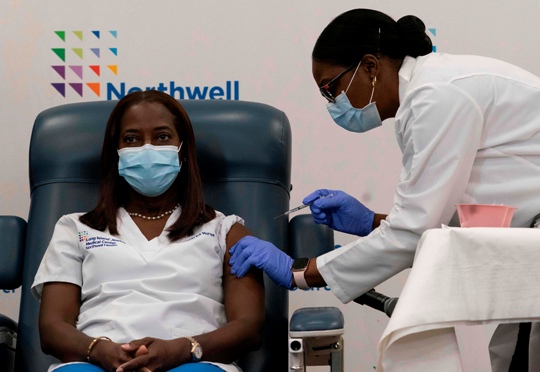1st vaccination in US is given in New York
Hard hit in outbreak’s first days
By Luis Ferré Sadurní and Joseph Goldstein
NEW YORK — The first coronavirus vaccination in the United States took place on Monday (14) morning in Queens, state officials said, signalling a turning point in the battle against a pandemic that has profoundly scarred New York, killing more than 35,000 people and severely weakening the economy.
Sandra Lindsay, an intensive care nurse at Long Island Jewish Medical Centtr, received the shot, the first outside of a vaccine trial, shortly after 9:00 a.m. during a news conference with Gov. Andrew Cuomo.
The vaccine arrives at a time of urgency, with the state now confronting a worsening second wave after a relatively dormant period in the summer.
The state recorded an average of 10,048 cases per day last week, an increase of 72% from two weeks earlier. Patients are filling up hospital beds in numbers not seen since May.
Now, nearly 300 days after the state reported its first coronavirus case on March 1, health officials face another race against time to protect vulnerable New Yorkers from a now familiar foe. The distribution of a vaccine that has been fast-tracked in each stage of the process, from development to approval by the Food and Drug Administration on Friday (11) night, figures to provide many logistical challenges.
“This vaccine is exciting because I believe this is the weapon that will end the war,” Cuomo said during the news conference. “We have planes, trains and automobiles moving this all over the state right now. We want to get it deployed, and we want to get it deployed quickly.”
The shipment Monday is part of the state’s initial allocation to vaccinate people deemed most essential or at-risk, a group that includes front-line health care workers, as well as staff members and residents of nursing homes and long-term care facilities.
Mayor Bill de Blasio said in an interview on CNN on Monday morning that the first doses of the vaccine had arrived in New York City and that he would visit a hospital later in the day to watch a health care worker receive one of the first shots. De Blasio said the vaccine offered hope to the city, and New Yorkers could now see the light at the end of the tunnel.
“It’s going to be a good day,” the mayor said.
State officials are anticipating enough doses from the drugmaker Pfizer to begin inoculating 170,000 people. The process requires two doses for each person, administered a few weeks apart.
As soon as next week, the state is expecting 346,000 additional doses from drugmaker Moderna, which is still waiting for FDA approval for emergency use of its vaccine.
Those initial batches will begin to cover just over a quarter of the estimated 1.8 million people prioritized to receive the vaccine in the first phase of distribution in the state. Getting through those high-priority vaccinations will also take some time — state officials project to conclude the first phase sometime in January.
The second phase of vaccinations will cover so-called essential workers, an expansive category of workers that has yet to be defined, but which may include police officers, fire-fighters, teachers, pharmacists, grocery store workers, public transit employees and others. This stage would also include individuals in the general population with comorbidities and underlying health conditions that especially put them at risk to contracting the virus.
Across the region, officials have begun preparation for the vaccine’s arrival.
In New Jersey, where nearly 18,000 deaths have been linked to the virus, the first doses of vaccine will be administered to nurses in Newark, the state’s hardest-hit city. Staff members from University Hospital, New Jersey’s only public hospital, will be first in line, beginning at 8:00 a.m. Tuesday (15), state officials said.
As of Friday evening, state officials were still scrambling to decipher the specifics of the vaccine’s much-anticipated arrival, as they waited for the federal government to grant the Pfizer vaccine, developed in conjunction with BioNTech, the necessary emergency use authorization. Approval came late that evening, setting off a chain of events that finally brought the vaccine to New York.
-New York Times


